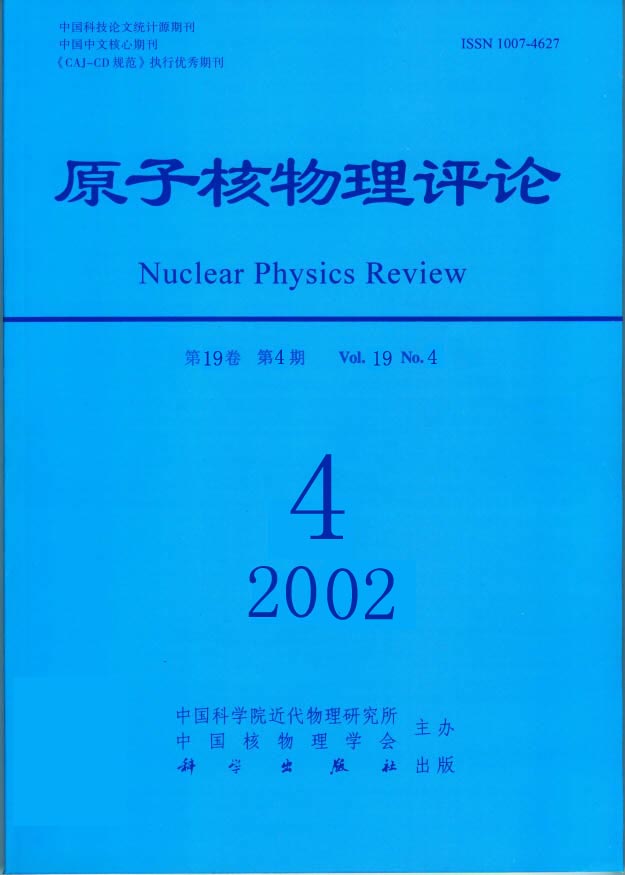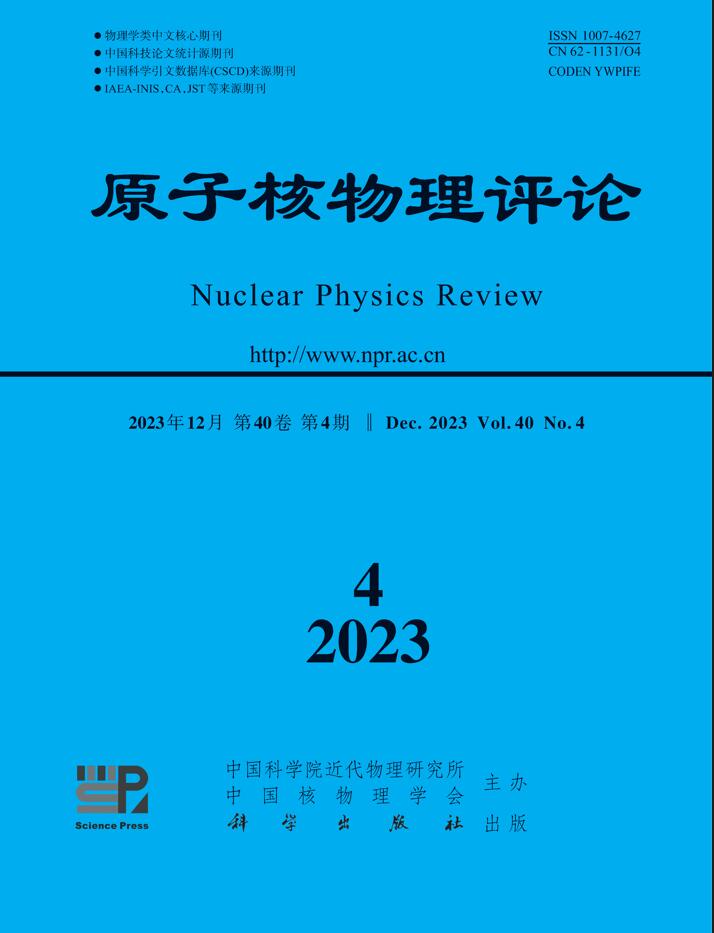2002 Vol. 19, No. 4

Display Method:
2002, 19(4): 365-372.
doi: 10.11804/NuclPhysRev.19.04.365
Abstract:
The current status on the theoretical investigations of the nuclear shell model is reviewed, and the fundamental problems in shellmodel studies are mentioned. Basically the shellmodel uses a very intuitive approach to study the nuclear manybody dynamics in terms of valence particles. It assumes that the nucleons, belonging to a closed core, do not participate in the establishment of the nuclear spectrum. One of the main problems in the (traditional) shell model is to make a calculation...
The current status on the theoretical investigations of the nuclear shell model is reviewed, and the fundamental problems in shellmodel studies are mentioned. Basically the shellmodel uses a very intuitive approach to study the nuclear manybody dynamics in terms of valence particles. It assumes that the nucleons, belonging to a closed core, do not participate in the establishment of the nuclear spectrum. One of the main problems in the (traditional) shell model is to make a calculation...
2002, 19(4): 373-379.
doi: 10.11804/NuclPhysRev.19.04.373
Abstract:
The Measurement of energetic photon produced in intermediate energy and relativistic energy heavy ion collisions provides opportunities for investigating many interesting and sophisticated problems such as properties of nuclear matter under extreme condition, bremsstrahlung, neutral meson production both below and above the production threshold in free nucleonnucleon collision. The related experiments performed at GANIL and GSI as well as the structure of the popular used detector ...
The Measurement of energetic photon produced in intermediate energy and relativistic energy heavy ion collisions provides opportunities for investigating many interesting and sophisticated problems such as properties of nuclear matter under extreme condition, bremsstrahlung, neutral meson production both below and above the production threshold in free nucleonnucleon collision. The related experiments performed at GANIL and GSI as well as the structure of the popular used detector ...
2002, 19(4): 380-386.
doi: 10.11804/NuclPhysRev.19.04.380
Abstract:
Observables that related to the flows in intermediate and relativistic energy heavy ion collisions are discussed .The flow parameters which describe directe flow, squeezeout and elliptic flow, as well as probing the equation of state, in medium n-n cross section and the dynamical emission are reviewed.
Observables that related to the flows in intermediate and relativistic energy heavy ion collisions are discussed .The flow parameters which describe directe flow, squeezeout and elliptic flow, as well as probing the equation of state, in medium n-n cross section and the dynamical emission are reviewed.
2002, 19(4): 387-389.
doi: 10.11804/NuclPhysRev.19.04.387
Abstract:
Total reaction cross section (σt) was measured for neutonrich nuclei 6He on 28Si target from about 20 to 40 MeV/u and compared with Warner s experimental data. It is found that the total cross section of 6He on 28Si depends on the energy and it can be fitted well by Glauber model using twoterm HO density distribution from high energy data of 6He.
Total reaction cross section (σt) was measured for neutonrich nuclei 6He on 28Si target from about 20 to 40 MeV/u and compared with Warner s experimental data. It is found that the total cross section of 6He on 28Si depends on the energy and it can be fitted well by Glauber model using twoterm HO density distribution from high energy data of 6He.
2002, 19(4): 390-394.
doi: 10.11804/NuclPhysRev.19.04.390
Abstract:
The spallation neutron target for intermediate energy proton incident is an important link for accelerator and subcritical reactor of accelerator driven system (ADS). The theoretic programs and Monte Carlo codes are a useful approach for solving the physics of spallation neutron source. We discuss those codes at present work and introduce the application and development of SHIELD code.
The spallation neutron target for intermediate energy proton incident is an important link for accelerator and subcritical reactor of accelerator driven system (ADS). The theoretic programs and Monte Carlo codes are a useful approach for solving the physics of spallation neutron source. We discuss those codes at present work and introduce the application and development of SHIELD code.
2002, 19(4): 395-398.
doi: 10.11804/NuclPhysRev.19.04.395
Abstract:
As an ultra high sensitive analyzing method, accelerator mass spectrometry is playing an important role in the studies of nuclear physics and astrophysics. In this article, accelerator mass spectrometry (AMS) applications in searching for violation of Pauli exclusion principle and study on supernovae are discussed as examples.
As an ultra high sensitive analyzing method, accelerator mass spectrometry is playing an important role in the studies of nuclear physics and astrophysics. In this article, accelerator mass spectrometry (AMS) applications in searching for violation of Pauli exclusion principle and study on supernovae are discussed as examples.
2002, 19(4): 399-402.
doi: 10.11804/NuclPhysRev.19.04.399
Abstract:
In order to satisfy the requirement of beam injection and extraction of CSR, four magnetic septums will be used in the accelerator. In the design, the shape of the lamination is optimized by 2-D magnetic field calculation. Also, in order to decrease the leakage field and obtain a satisfied field distribution, a special auxiliary coil and a shield iron plate are considered and as well as the construction of the septum leg is treated in a special way. As a result, the leakage field is almost...
In order to satisfy the requirement of beam injection and extraction of CSR, four magnetic septums will be used in the accelerator. In the design, the shape of the lamination is optimized by 2-D magnetic field calculation. Also, in order to decrease the leakage field and obtain a satisfied field distribution, a special auxiliary coil and a shield iron plate are considered and as well as the construction of the septum leg is treated in a special way. As a result, the leakage field is almost...
2002, 19(4): 403-406.
doi: 10.11804/NuclPhysRev.19.04.403
Abstract:
The principle of automatic beam tuning of accelerator based on genetic algorithms(GA) is expounded. Designing method of the automatic beam tuning system is introduced. Computer simulation results are presented, and the research direction of automatic beam tuning is discussed.
The principle of automatic beam tuning of accelerator based on genetic algorithms(GA) is expounded. Designing method of the automatic beam tuning system is introduced. Computer simulation results are presented, and the research direction of automatic beam tuning is discussed.
2002, 19(4): 407-410.
doi: 10.11804/NuclPhysRev.19.04.407
Abstract:
The particle motion equation has been reduced to the pendulum equation with a δmoment by using sinesquared potential. The phase planar characteristics have been analysed for a nonperturbed systeam . The dechanneling effects have been calculated numerically for a perturbed system. The relationship between the dechanneling fraction and superlattice deformation in resonance has been discussed.
The particle motion equation has been reduced to the pendulum equation with a δmoment by using sinesquared potential. The phase planar characteristics have been analysed for a nonperturbed systeam . The dechanneling effects have been calculated numerically for a perturbed system. The relationship between the dechanneling fraction and superlattice deformation in resonance has been discussed.
2002, 19(4): 411-415.
doi: 10.11804/NuclPhysRev.19.04.411
Abstract:
This article introduces briefly the experimental and theoretical methods that have been used to study highenergy protoninduced single event effect in semiconductor devices. The theoretical methods including nuclear reaction analysis method and semiempirical method are presented. The relationship of upset cross section between proton and heavy ions is described. Finally, onorbit proton upset rates are predicted by using the heavyion test data.
This article introduces briefly the experimental and theoretical methods that have been used to study highenergy protoninduced single event effect in semiconductor devices. The theoretical methods including nuclear reaction analysis method and semiempirical method are presented. The relationship of upset cross section between proton and heavy ions is described. Finally, onorbit proton upset rates are predicted by using the heavyion test data.
2002, 19(4): 416-420.
doi: 10.11804/NuclPhysRev.19.04.416
Abstract:
32 trace element contents in each sample are measured by neutron activation analysis for the selected that 19 samples of terracotta warriors and horses from No.2 pit of Emperor Qin Shihuang s Mausoleum, 20 samples clay nearby Qin s Mausoleum and 2 samples of Yaozhou porcelain bodies. The trend cluster analysis diagram is obtained after sortting the data. The results show that the samples from the No.2 pit of Emperor Qin Shihuang s Mausoleum have a close relationship with the clay ..
32 trace element contents in each sample are measured by neutron activation analysis for the selected that 19 samples of terracotta warriors and horses from No.2 pit of Emperor Qin Shihuang s Mausoleum, 20 samples clay nearby Qin s Mausoleum and 2 samples of Yaozhou porcelain bodies. The trend cluster analysis diagram is obtained after sortting the data. The results show that the samples from the No.2 pit of Emperor Qin Shihuang s Mausoleum have a close relationship with the clay ..
2002, 19(4): 421-424.
doi: 10.11804/NuclPhysRev.19.04.421
Abstract:
Terracotta warriors and horses of Qin Shihuang s Mausoleum is famous in the world, but their original place of raw material is still a riddle up to now. 42 samples of pottery warriors and horses of Qin Shihuang s Mausoleum in pit No.3, 20 samples of clay nearby Museum of the terracotta warriors and horses of Qin Shihuang s Mausoleum are selected and prepared for analysis. The contents of 32 microelement are measured by neutron activation analysis (NAA), the eight elements are chosen as the...
Terracotta warriors and horses of Qin Shihuang s Mausoleum is famous in the world, but their original place of raw material is still a riddle up to now. 42 samples of pottery warriors and horses of Qin Shihuang s Mausoleum in pit No.3, 20 samples of clay nearby Museum of the terracotta warriors and horses of Qin Shihuang s Mausoleum are selected and prepared for analysis. The contents of 32 microelement are measured by neutron activation analysis (NAA), the eight elements are chosen as the...
2002, 19(4): 425-430.
doi: 10.11804/NuclPhysRev.19.04.425
Abstract:
Nuclear data evaluation and database in mediumhigh energy region in the world are briefly discussed. Especially, experimental measurements, theoretical calculations, benchmark testing, evaluation and database construction in mediumhigh energy range are discussed in more detail. And the suggestion on nuclear data work for the future at mediumhigh energy in China is given.
Nuclear data evaluation and database in mediumhigh energy region in the world are briefly discussed. Especially, experimental measurements, theoretical calculations, benchmark testing, evaluation and database construction in mediumhigh energy range are discussed in more detail. And the suggestion on nuclear data work for the future at mediumhigh energy in China is given.







 甘公网安备 62010202000723号
甘公网安备 62010202000723号